
After a quick train ride to Egna-Termeno station, I walked up through the Alpine vineyards and orchards to Brennerei Psenner. This is one of several whisky makers in South Tyrol (which make this the hotbed for Italian whisky). As if to illustrate the point, Psenner is one of the only distilleries from which I can also see the door of an entirely separate distillery: Roner.

Story
I was welcomed by distiller and owner Werner Psenner, who graciously took a few hours out of his afternoon to show me around. A lively and energetic man with a glint in his eye like a mad professor, Werner is very happy to talk to me, a stranger who he barely knows. He has a fun style!
Brennerei Psenner was started back in 1947 by Werner’s grandfather, Ludwig. The Psenner family comes from a village just above Tramin, the town behind us which Werner points out through the window. Tramin is what gewürztraminer wine is named for, and Brennerei Psenner is the last stop on each year’s Gewürztraminer WineDay Walk.
This area is not just the Sud-Tirol, but part of what Werner calls a ‘missing culture’ trapped between Austria, Switzerland, and Italy. Around Tramin, the language of Ladin (descended from Latin and pre-Roman Rhaetian languages) is spoken. The town’s name comes from ‘termeno’, as it was the original terminus of the Via Claudia Augusta.
Rhaetians were making wine here even before the Romans showed up, and Werner also claims barrels originated here. I think the Gauls would have something to say about that, but the Romans did pick up coopering methods during the imperial period, moving away from old clay amphorae.
Werner also claims that his grandfather Ludwig was the first distiller of fruit brandies (not grappa) in Italy, most notably Williams pear brandy. This owes something to schnapps distilling coming in from the north, and pears being grown to the south coming together. Werner also places great emphasis on single grape varieties as a way to improve grappa quality, just like using a single kind of fruit.
Upon inheriting the family business, Werner started moving more into cask ageing. Today, he manages a portfolio of 50 products. By now, he has almost 30 years of practice ageing spirits in casks. His oak-aged grappas won awards just this year. He describes to me how ageing fruit spirits can be especially tricky: you can easily overwhelm or remove all the fruit flavour!
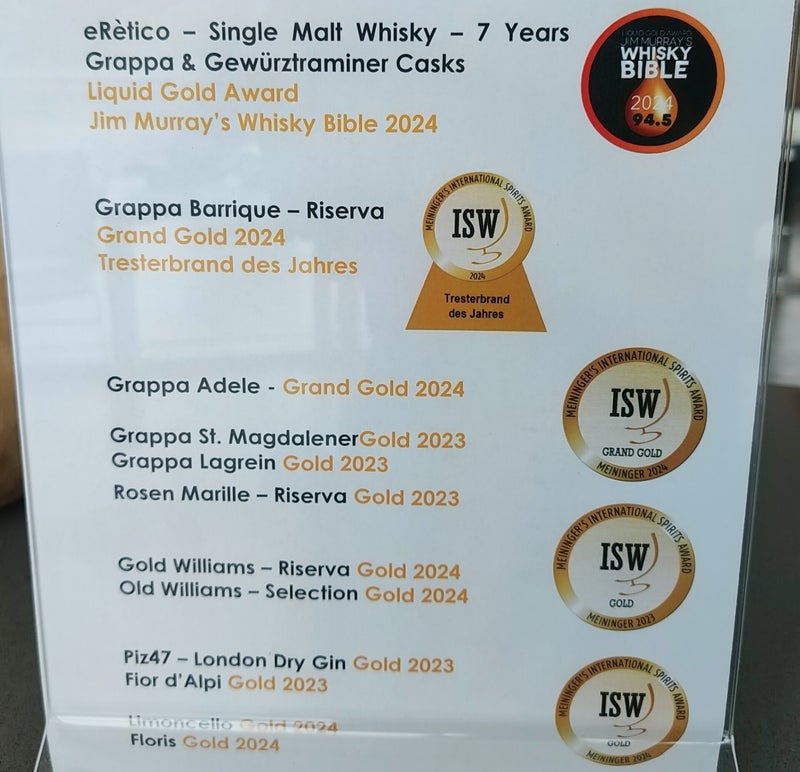
Distilling
When it came to making whisky, Werner had a clear goal - make ‘whisky born in a grappa cask’. In his first few years making whisky, Werner found the fermentation tricky and unreliable. Werner was helped in developing Psenner whisky by Lucas, a local engineering student who used his knowledge studying in Munich and working with Weihenstephan.


Grappa stills include old pots and small columns, all hooked up in one interweaved system. Those used to seeing a handful of clearly distinct pot stills at a Scottish or Irish distillery will not be ready for this! Werner describes the process as producing a triple distilled grappa, and he uses the same process for whisky - so this is triple distilled, but with an asterisk.
Psenner produces whisky from March to June, outside the grappa season. They use a dedicated whisky yeast, fermenting for at least 100 hours in search of more fruitiness. Werner did try using yeast from his fruit brandy production but the results were apparently poor. He has a strong disincentive to experiment with yeast - he maintains precise strains for his brandies and grappas, and any contamination would ruin those!
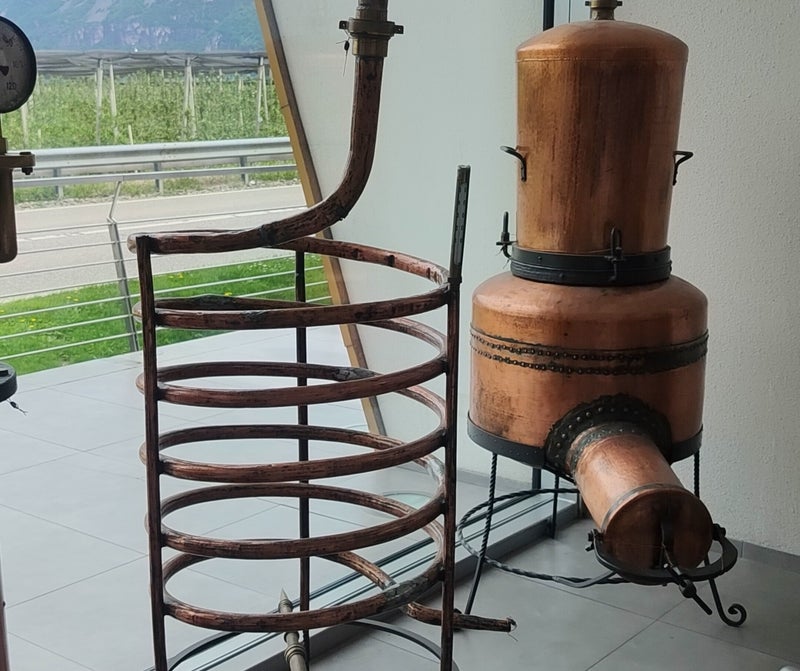
An old still in the distillery's entrance way...
Details
- Munich and Cara malt (unsmoked), sourced from Weyerman in Bamberg
- All single malt production
- Over 100hrs fermentation
- ‘Triple distilled’ - 2x 900L stills and 2x 600L
- 81% ABV new make - No chill-filtering
- 30,000 LPA
Ageing
If there’s one thing Werner knows relative to whisky, it’s oak. When he opens the warehouse door, cold air rushes out. It’s a big place, with 9 levels of racks for casks, and more in the roof area where they can experience stronger seasonal temperature swings. The Psenner warehouse contains more than 80 cask types! Most are new French oak - these cover about 80% of all casks used for grappa at Psenner. These get re-used twice, or only once if turned over to whisky maturation.

All Psenner’s casks are locked in by customs, as is the Italian way. They allow 4% of angels’ share annually - yes, if you get more than that, Italian excise just doesn’t believe you! All Psenner’s whisky new make spends a few months waiting before being put into casks - waiting for grappa to come out of them - which might affect its final flavours.

Werner often goes to collect new barrels himself, to make sure he’s getting the right stuff. He hints there may be apple and apricot brandy casks coming for whisky maturation soon too…
Despite so much attention being paid to oak, Werner describes his whisky as ‘calm’ - he doesn’t want to pile on too much wood flavour. The idea is for wine casks to ‘help the structure of the whisky’, not to simply imprint a wine’s flavour onto it.
This chimed with one point which emerged a lot during my Italy trip - the smokescreen behind “Amarone cask” whiskies. Many don’t actually have Amarone wine in them - it doesn’t even need to be aged (unless it's riserva). Even if aged, it only gets 6 months in oak before moving to big terracotta vessels. At 17%, Amarone is also a very high ABV wine - an acidic sweet wine.

In contrast, Werner’s casks are genuine Amarone which - most importantly - are washed before use, so you don’t just add residual wine into your whisky and mix the flavours together. When the barrels of whisky are emptied, Werner marries the contents in a tank together for up to a year, again for a ‘calming’ effect.
It’s warm enough around Tramin that Psenner spirit increases in ABV in the cask - climbing by 10% over 10 years! While it can get down to 5C in the winter here, summers are hot and the winters are especially dry. Werner now adjusts for the effects of this low humidity by diluting his new spirit to 55% before putting it in the cask.
Tasting
When it comes to tasting, we use a stem grappa glass, not a Glencairn, as Werner believes that this separates the layers of aroma better. All his whisky is single malt, all bottled under the brand eRètico. The name nods to both the ‘heretical’ nature of making whisky in the heart of grappa and wine country, and to the Italian word for Rhaetian (‘retico’).

Smelling an older sample of eRètico new make, it’s dark and earthy. There’s a little raw, vegetal sweetness - Werner says the more current batches smell more like pumpernickel and speck. Very relevant flavours for the South Tyrol! Considering this is a triple distilled single malt, you suddenly realise how distinct eRètico is from many other whiskies. Where else do you get that spicy, heavy depth in something triple distilled?
The first whisky I get to try is the eRètico Grappa & Sherry (5 years old, 43% ABV), bottled in 2023. Nosing this blind, I would have thought this was a dram of Scheibel Mühle!

A 3 year old version of this whisky was Psenner’s first whisky, released in 2016. This older version has a lighter palate than the nose suggests, with sour notes of dark chocolate and hazelnuts. French oak and a bit more sweetness come through on the finish. There’s quite a difference between the nose and palate overall, which Werner puts down to his grappa having similar characteristics.
Speaking of grappa, I couldn’t leave Psenner without trying at least one. Werner pours me some bright red St Magdalena. This is made using a local red wine grape, and the nose is a little sour and earthy. However, as I taste it, there’s sweetness, hazelnuts, walnuts, and the finish is lavender and violets. This is not only a nice grappa - certainly the best I’ve ever tried - but the St Magdalena grappa casks are what Werner uses to age the eRètico grappa expression.
Moreover, St Magdalena grapes are only used to make grappa here at Psenner, so it is a completely unique grappa. ‘Santa Magdalena is calm’, Werner says, ‘while gewürztraminer grappa is like a drag queen'. It would be too lively and strong a flavour, he thinks, to use for whisky maturation.
By comparison, many other grappas have potatoey, doughy notes on the nose - Werner hands me a quick sample to prove the point. Werner had to choose a grappa which wasn’t too floral or overpowering. This whisky spends three years in grappa, and two in sherry. These whiskies have been further refined thanks to the pandemic, which gave Werner plenty of time to go through 800 cask samples!
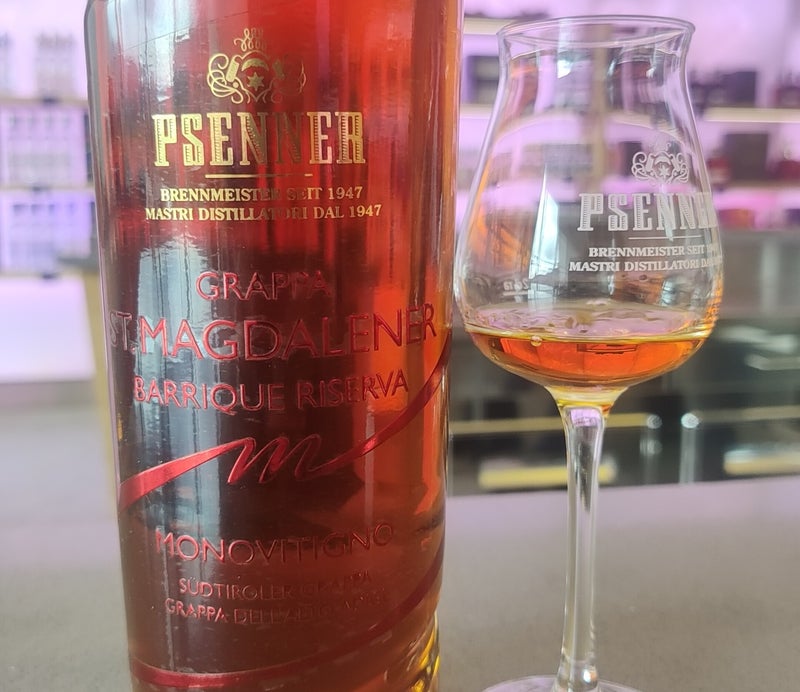
Returning to the whisky, the comparison between it and the grappa becomes more clear. In my opinion, it reminds me just how much more I enjoy whisky. The French oak notes, chocolate, and plum all stand out more now.
The eRètico Gewürztraminer expression (7 years old, 47%) uses second fill wine casks, and I think the sweet white wine notes here are just perfect. Not overwhelming, but relative to the other expressions, the wine gives this whisky a real lift. That earthiness now has a counterbalance, without removing the hazelnut and chocolate notes of…
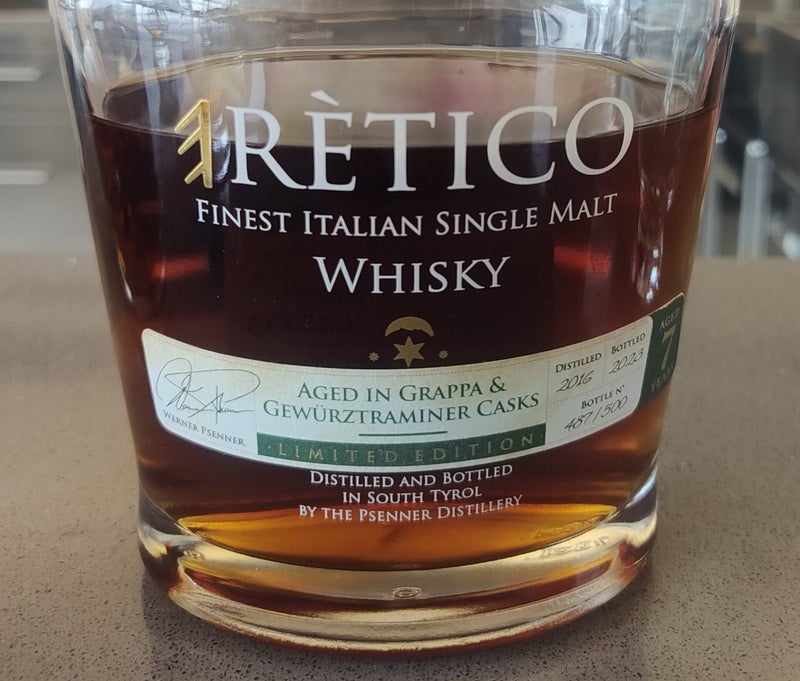
The eRètico Amarone (also 7 years old and 47% ABV) is a more limited release. You can immediately sense the dry tannins, the nose is full of French oak, but it remains pleasant amid that heaviness. It's a little sweeter than the last whisky - and a little redder. Werner had tried ageing whisky for three years in first fill Amarone casks, but apparently this was just too intense.

As I add water to these whiskies, Werner warns not to do this with grappa - it doesn’t take water as well as whisky. Unless it’s super fruity, you’ll not enjoy dropping grappa to much below 42-43%. Thankfully, this is not a concern with the eRètico Amarone, which I think improves as it becomes a little sweeter.
Psenner and the Italian whisky world
While Italy has slept on whiskymaking itself, Werner predicts it is starting from a real place of strength. Grappa is a different world from whisky. You have maybe 100 distilleries making most of it, Werner estimates: there isn’t a robust range of microdistilleries there. While Puni is famous for being the first Italian whisky distillery, Psenner’s website describes itself as the home of ‘South Tyrol’s first single malt whisky’.
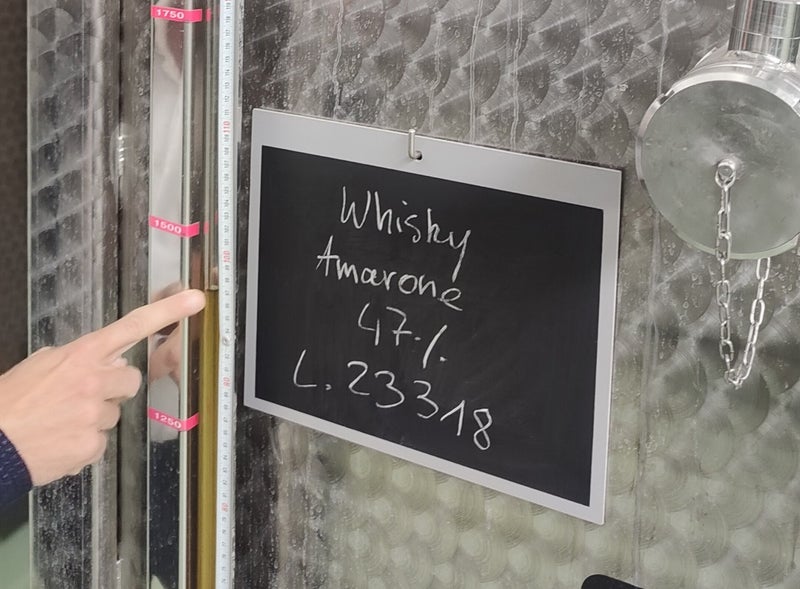
Werner explains to me that Puni’s first whisky wasn’t strictly a single malt, so he can technically make the claim. Puni represented an evolution of Scotch whisky, while Werner tried to make something more aligned with the history of grappa and wine in the area.
Psenner whisky has already made it out of Italy - into Austria, Japan, Germany, and in the UK, US, and Czech Republic. While they started with small batches of 2,500 bottles per year, Psenner’s whisky production has accelerated rapidly alongside its massive existing grappa business. Batches as big as 5,000 bottles are coming up, with the eventual goal of 15,000. For scale, the whole distillery churns out 500,000 bottles per year, so the whisky is still very much a side project in terms of quantity. Whisky is also Psenner’s most expensive product.
The Italian whisky market itself is also changing. Starting in the 1970s, Italy became one of the big consumer countries for Scotch single malts by fans and connoisseurs in place of casual drinkers. In particular, Italy was one of the first places to really seize on heavily peated Islay single malts. The shift in today’s market there can be seen at Whisky Club Italia, whose average age has dropped from 49 (in 2019) to 29 today. Now, there is more experimentation, more willingness to find something new. Italian whisky and Italian whisky lovers are really becoming ever more connected to a wider whisky world. I was flattered to find out that Werner even used the EuroWhisky Map at a masterclass in Torino!
Thanks to Werner and the staff at Brennerei Psenner for allowing me to visit and try eRètico whiskies. If you're in the South Tirol, check out these whiskies and use it as an excuse to see the beautiful scenery and try some Gewürztraminer wine for yourselves!

If you stop by the distillery and want a little fact file about Psenner whiskies, then you can pick up one of these little passports…


Add comment
Comments